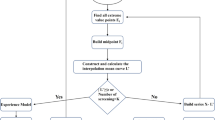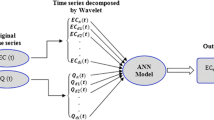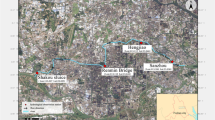Abstract
This paper developed wavelet decomposition and Seq2Seq hybrid models (W-Seq2Seq) to predict water quality. Four Seq2Seq models, namely one-layer unidirectional model (Uni1), one-layer bidirectional model (Bi1), two-layers unidirectionalmodel (Uni2) and two-layers bidirectional model (Bi2) were proposed in this study. Daubechies5 (db5) wavelet was used to decompose datasets into low frequency series and high frequency series, and these low frequency signals were used as the inputs of the proposed models. Data series of four water quality indices (pH, NH4-N, Conductivity and Turbidity) collected from the Menlou Reservoir in China were used for model training, validation and testing. The main results show that all the four models have very good performances to fit the historical datasets during the training process. Whereas, the comparison testing results suggest that Bi2 are superior to the other three models in terms of prediction accuracy and generalization ability, which can significantly improve the prediction accuracy of water quality data with high complexity.




Similar content being viewed by others
REFERENCES
Barzegar, R., Aalami, M.T., and Adamowski, J.F., Coupling a hybrid CNN-LSTM deep learning model with a boundary corrected maximal overlap discrete wavelet transform for multiscale lake water level forecasting, J. Hydrol., 2021.
Bowden, G.J., Maier, H.R., and Dandy, G.C., Optimal division of data for neural network models in water resources applications, Water Res. Res., 2002, vol. 38, no. 2, pp. 2‒1.
Chen, Y., Xia, J., Cai, W., Sun, Z., and Dou, C., Three-phase-based approach to develop a river health prediction and early warning system to guide river management, Appl. Sci., 2019, vol. 9, no. 19, p. 4163.
Guan, B., An, S., and Gu, B., Assessment of ecosystem health during the past 40 years for lake Taiho in the Yangtze river delta, China, Limnology, 2011, vol. 12, no. 1, pp. 47‒53.
Guo, T.Y., Cheng-Dong, W.U., and Dao-Kui, Q.U., Wavelet transform theory and its application progress: a review, Inform. Control, 2004, vol. 01, pp. 67‒71.
Hara, J., Mamun, M., and An, K.G., Ecological river health assessments using chemical parameter model and the index of biological integrity model, Water, 2019, vol. 11, no. 8, p. 1729.
Hochreiter, S., Untersuchungen zu dynamischen neuronalen, Netzen, 1991.
Jia, X.W., Karpatne, A., Willard, J., Steinbach, M.S., Read, J.S., Hanson, P.C., Dugan, H.A., and Kumar, V., Physics guided recurrent neural networks for modeling dynamical systems: application to monitoring water temperature and quality in lakes, arXiv: Learning, 2018, vol. 08, pp. 19‒21.
Kao, I.F., Zhou, Y., Chang, L.C., and Chang, F.J., Exploring a long short-term memory based encoder-decoder framework for multi-step-ahead flood forecasting, J. Hydrol., 2020, 124631.
Kumar, D.N., Raju, K.S., and Sathish, T., Water Resour. Manag., 2004, vol. 18, no. 2, pp. 143‒161.
Lee, G.R., Gommers, R., Waselewski, F., Wohlfahrt, K., and O’Leary, A., PyWavelets: A Python package for wavelet analysis, J. Open Source Software, 2019, vol. 4, no. 36, p. 1237.
Lin, S.L. and Huang, H.W., Improving deep learning for forecasting accuracy in financial data, Discrete Dynamics in Nature and Society, 2020, pp. 1‒12.
Liu, P., Wang, J., Sangaiah, A. K., Xie, Y., and Yin, X., Analysis and prediction of water quality using LSTM deep neural networks in IOT environment, Sustainability, 2019, vol. 11, no. 7, p. 2058.
Sun, M., Wei, S., Wang, Y., Zhao, J., and Yuan, M., Prediction model of water quality based on wavelet decomposition and LSTM, Comp. Syst. Applic., 2020, vol. 29, no. 12, pp. 59‒67.
Tao, T. and Xin, K., Public health: a sustainable plan for China’s drinking water, Nature, 2014, vol. 511, no. 7511, p. 527.
Vinyals, O., Bengio, S., and Kudlur, M., Order matters: sequence to sequence for sets, Comput. Sci., 2015.
Wang, Q. and Yang, Z., Industrial water pollution, water environment treatment, and health risks in China, Environ. Pollut., 2016, vol. 218, pp. 358‒365.
Wei, S., Zuo, D., and Song, J., Improving prediction accuracy of river discharge time series using a Wavelet-NAR artificial neural network, J. Hydroinf., 2012, vol. 14, no. 4, pp. 974‒991.
Wu, C.L., Chau, K.W., and Li, Y.S., Methods to improve neural network performance in daily flows prediction, J. Hydrol., 2009, vol. 372, nos. 1–4, pp. 80–93.
Xiang, Z., Yan, J., and Demir, I., A rainfall-runoff model with lstm-based sequence-to-sequence learning, Water Resour. Res., 2020, vol. 56, no. 1.
Xie, Z., Liu, Q., and Cao, Y., Hybrid Deep Learning Modeling for Water Level Prediction in Yangtze River, Intel. Autom. & Soft Comput., 2021, vol. 28, pp. 153‒166.
Xu, J., Wang, K., Lin, C., Xiao, L., Huang, X., and Zhang, Y., FM-GRU: A time series prediction method for water quality based on seq2seq framework, Water, 2021, vol. 13, no. 8, p. 1031.
Yang, Y., Xiong, Q., Wu, C., Zou, Q., Yu, Y., Yi, H., and Gao, M., A study on water quality prediction by a hybrid CNN-LSTM model with attention mechanism, Environ Sci. Pollut. Res., 2021, pp. 1‒11.
Funding
This work was supported by the Natural Science Foundation of Shandong Province, China (no. ZR2020MF148).
Author information
Authors and Affiliations
Corresponding author
Rights and permissions
About this article
Cite this article
Yuan, M., Wei, S., Sun, M. et al. Wavelet Decomposition and Seq2Seq Hybrid Models for Water Quality Prediction. Water Resour 49, 743–752 (2022). https://doi.org/10.1134/S0097807822040212
Received:
Revised:
Accepted:
Published:
Issue Date:
DOI: https://doi.org/10.1134/S0097807822040212




